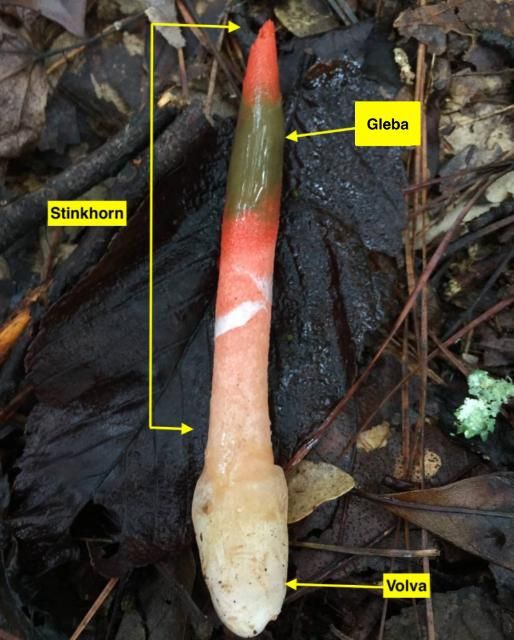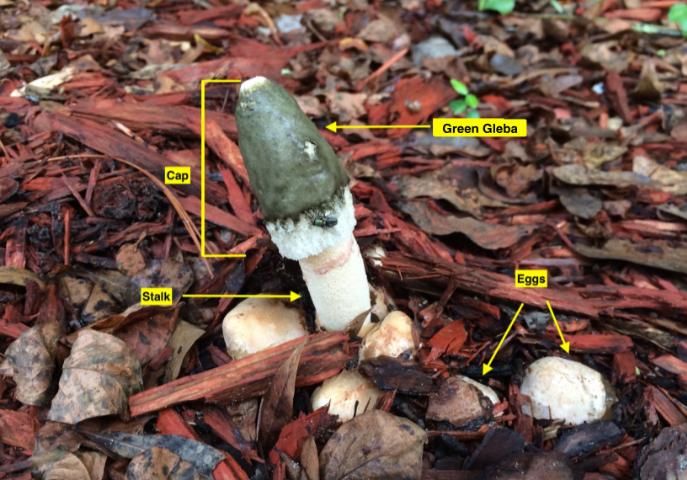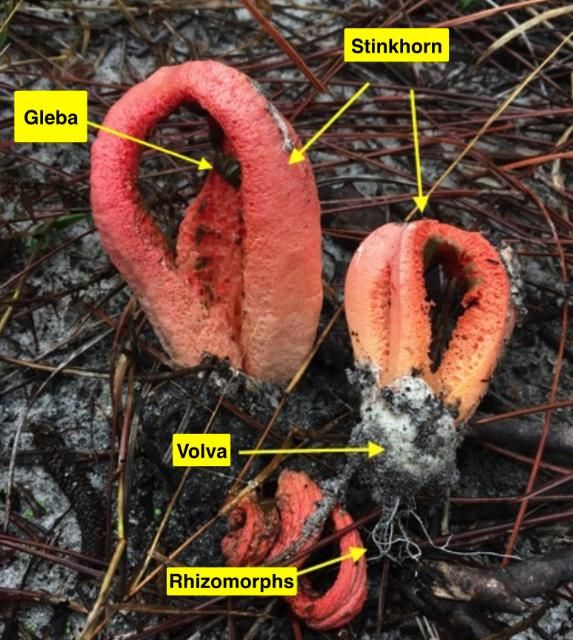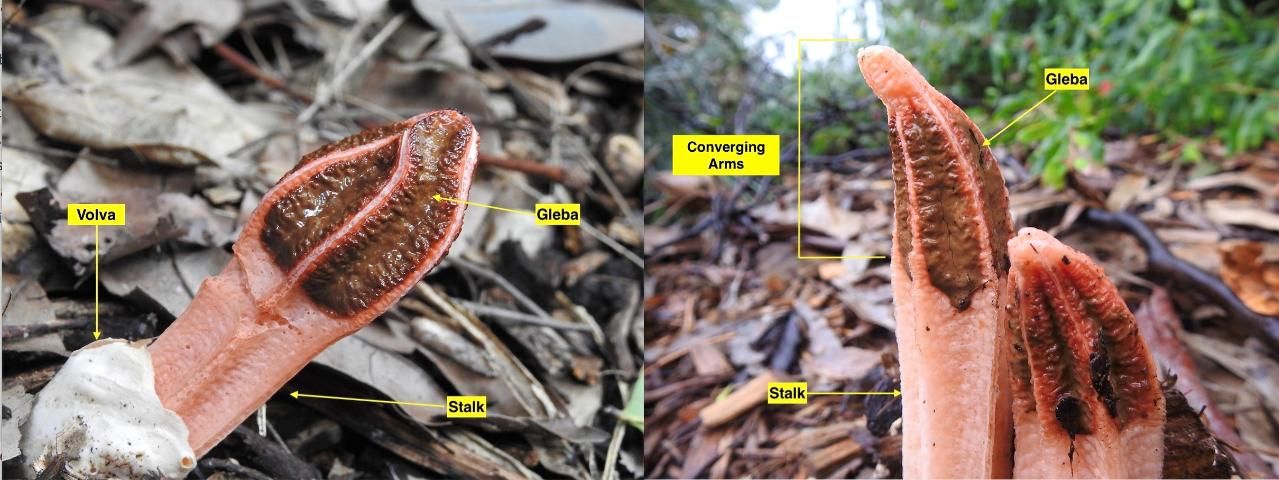Summary
"You'll smell them before you see them!" is a common statement of caution experienced mushroom foragers will tell you when discussing stinkhorn mushrooms. Stinkhorns give off a strong, offensive, rotting odor. The odor is typically described as smelling of rotting dung or carrion or a combination of the two. Many stinkhorns have a phallic appearance, which has led to their inclusion in different folklore and cultural superstitions worldwide. In fact, the taxonomic name for this group is the Phallales in reference to their phallic appearance, and one common genus in this group of fungi is the genus Phallus. Their common name is derived from "stink" (for the foul smell they emit) and "horn" (for the shape of the mature fruiting body). Stinkhorns are not considered poisonous. However, if there are concerns about a child or pet eating a stinkhorn, refer to the photos and figures in this document to be sure that the mushroom which was ingested is a stinkhorn. When in doubt about an ingested fungus in the state of Florida, contact the American Association of Poison Control Centers hotline 1 (800)-222-1222 or Dr. Matthew E. Smith (trufflesmith@ufl.edu, 352-273-2837).
Introduction
Although most mushroom-forming fungi release their spores into the wind for dispersal, stinkhorns are different in that they do not have this ability, and therefore use other methods to disperse to new areas. Fungi that do not release their spores into the wind are sometimes referred to as gasteromycetes (stomach fungi) or sequestrate fungi (because they sequester their spores away). Many gasteromycete fungi, including the stinkhorns, utilize other organisms for spore dispersal. Stinkhorns are given their name due to the smell emitted from the slimy spore mass that is most often exposed at the top of their stalks at maturity. The spore mass is typically referred to as the gleba. This smell is useful in attracting insects and other invertebrates that spread the spores to new locations. Stinkhorn mushrooms typically grow on decaying wood or other plant material (Bessette et al. 2007). Stinkhorns are especially common in the mulch of home gardens in Florida and across the Gulf Coast region.
Stinkhorns are not poisonous. Despite their unpleasant odor, stinkhorns are eaten in a variety of ways ranging from use as salad toppings, in soups, incorporation in sausages and pickled items, and as a short-term food preservative (Laessøe and Spooner 1994). The flavor of Phallus impudicus, known as the common stinkhorn, is reported to resemble hazelnuts when eaten in its egg stage (Kibby 2015). The stinkhorn Phallus indusiatus is even considered a delicacy in China, where it is commercially grown and consumed in many different recipes (Laessøe and Spooner 1994). Four common species of Florida stinkhorn mushrooms are described in this document: Phallus ravenelli, Clathrus columnatus, Mutinus elegans, and Lysurus mokusin.
Morphology
The stinkhorns discussed in this document are in the family Phallaceae (Phallales, Basidiomycota). These species are first visible in the soil or mulch surface as small, round structures that are often called eggs (Hosaka et al. 2006). The eggs are usually attached to the mulch or other fruiting substrate through white cords of fungal tissue that are called rhizomorphs. As the fungus matures, the putrid-smelling spore mass (known as the gleba) forms within the egg. The stinkhorns can emerge very quickly from the eggs, sometimes in a matter of minutes, with the spore mass pushed above the soil or mulch surface so that it is visible somewhere on the stalk or stalks. The stalks of stinkhorns are usually white, red, or pink, but are sometimes other colors as well. The pungent spore mass of the stinkhorns is spread on aboveground surfaces to attract invertebrates. Studies have documented a wide variety of invertebrates that visit mature stinkhorns, including blowflies, beetles, bees, and slugs (Kibby 2015; Tuno and Nobuko 1998; Yamashita et al. 2018; Oliveira et al. 2000; Chen et al. 2014). The two most common genera of stinkhorn encountered in Florida are Phallus and Clathrus, but we occasionally have species of Mutinus and Lysurus as well.
Stinkhorns in the genus Phallus are given their name because they have a distinct phallic shape that is similar to male genitalia (Kibby 2015). The smelly spore masses of this genus are found coating the caps at the apex of the stalks (Kibby 2015). Stinkhorns in the genus Mutinus do not have caps at the top of their stalks like the Phallus species. The top of these mushrooms tapers off and the network of outer cells becomes tighter, "pinching in" the spores contained on the tip of the mushroom (Kibby 2015). Mutinus species tend to be less foul smelling than Phallus species, but this is not always the case (Kibby 2015).
Ecology and Phenology
Stinkhorns are predominately saprophytic fungi, feeding on dead and decomposing plant material. They play an important beneficial role as decomposers in their native ecosystems and in Florida backyards. Stinkhorns tend to form on wood chips, leaf litter, decayed stumps, and in soil. Insects play an especially important role in stinkhorn reproduction. Stinkhorns attract insects to disperse their spores by producing putrid smelling spore masses that are often located on brightly colored stalk surfaces. The smell of stinkhorns has been described as similar to decomposing flesh, rotting feces, and sewage. The volatile chemicals emitted from the spores are detected by invertebrates that then feed on the spore mass. The ingested spores are then dispersed via the foraging invertebrates' excrement, or sometimes they are transported to new sites via attachment to the invertebrate's body. The invertebrates receive the benefits of a food source from the stinkhorn and are essential to the spread and maintenance of genetic diversity as they move from one mushroom to the next. The role of invertebrates in stinkhorn reproduction is comparable to the mutually beneficial behavior of bees foraging on nectar of multiple flowers and spreading pollen from flower to flower (Xiaozhao et al. 2015). However, ecological interactions between invertebrates and stinkhorns remain poorly known and deserve further study.
Stinkhorn fungi are most diverse in tropical habitats, so they generally grow well in Florida and in the Gulf Coast region (Miller and Miller 1988). There are many stinkhorn species in Florida and along the Gulf Coast, but it is not always clear which species are native and which have been introduced. There is strong evidence that stinkhorn fungi can be introduced to new regions and become established (Despre-Loustau et al. 2009; Arora and Burk 1982; Sandoval-Levia et al. 2014; Chen et al. 2014). More work is needed to clarify the identity of our local species and to determine their true distributions. As with other fungi, molecular methods are increasingly being used to understand the evolution and diversity of these fungi (Hosaka et al. 2006; Trierveiler-Pereira et al. 2014).
In Florida, species of Phallus and Mutinus are most frequently found above ground in the summer months (June‒September), whereas Clathrus columnatus often can be found during the winter (December‒February). However, stinkhorns can be found in Florida during any month of the year when there is sufficient rain.
Toxicology
All species of stinkhorn described here are considered non-toxic. Many stinkhorns are considered edible and sometimes are used for culinary purposes in the egg stage (Bessette et al. 2007). The exception to this is the columned stinkhorn Clathrus columnatus, as there have been reports of poisoning after consumption of the mushroom by pigs (Bessette et al. 2007). We do not recommend the consumption of stinkhorns, but if you do consume any fungi you should be careful to correctly identify each fungus to the species level because there are several species of deadly poisonous fungi that exist in Florida and around the world.
I. Mutinus elegans
-
Names
Common name: Elegant Stinkhorn
This species can sometimes be confused with Mutinus caninus (common name Dog Stinkhorn) and with Mutinus ravenelii (common name Little Red Stinkhorn), which are similar in appearance.
-
Morphology
The eggs of Mutinus elegans begin as small, white, egg-like balls, 0.5‒1 inch (1.2‒2.5 cm) in diameter. The stalk of Mutinus elegans is 4‒7 inches (10‒18 cm) tall, and 0.5‒1 inch (1.2‒2.5 cm) wide. The stalk is rough, tapered at both ends, hollow, spongy, and ranges in color from orange to pink-orange and pink-red. The volva (the sack at the base of the stalk) is whitish, tough, and wrinkled. The spore mass is olive green to dull green, slimy, foul-smelling, and covers the upper half or upper third of the stalk (Bessette et al. 2007).

Credit: Jimmy Craine
II. Phallus ravenelli
-
Names
Common name: Ravenel's Stinkhorn
-
Morphology
The eggs of Phallus ravenelii resemble whitish-to-lilac colored puffballs. The eggs are oval-to-pear shaped and are between 1.4‒2.4 inches (3.5‒6 cm) tall and 1.3‒1.8 inches (3‒4.5 cm) wide. The stalk of this mushroom is 3‒7 inches (7.5‒18 cm) tall and 0.75‒1.5 inches (1.9‒3.9 cm) thick. The stalk is characteristically spongy, thick, hollow, and pitted in appearance. It ranges in color from rosy red to white and is often covered by slime. The stalk tapers to an enlarged head. The volva of Phallus ravenelii is whitish, membranous, and tough, and it often has rhizomorphs that are attached at the base. The spore mass is located on the upper quarter or less of the stalk, and is olive green-brown in color, slimy, and has a foul odor (Bessette et al. 2007).

Credit: Matthew E. Smith, University of Florida
III. Clathrus columnatus
-
Names
Common name: Columned Stinkhorn
Former scientific names include Linderiella columnata, Colonnaria columnata, and Linderia columnata.
-
Morphology
The columned stinkhorn begins in a round egg-like shape that is 1‒2.75 inches (2.5‒7 cm) wide, 2‒6 inches (5‒15.5 cm) tall. The mushroom emerges from a whitish, wrinkled volva with rhizomorphs that are attached at the base. The mature mushroom has no stalk, but instead is made of two to five spongy, orange-to-red columns that curve to merge at the top. The inner portion of the stinkhorn's columns are covered by an olive brown spore mass that is slimy and emits a foul odor (Figure 3).

Credit: Matthew E. Smith, University of Florida
IV. Lysurus mokusin
-
Names
Common name: Lantern Stinkhorn
This mushroom has a number of taxonomic synonyms in the scientific literature, including Lysurus brevipes, Lysurus sinensis, and Lysurus kawamurensis.
-
Morphology
Lysurus mokusin in its egg stage is white in color and 0.4‒1 inches (1‒3 cm) in diameter. The stalk is spongy and hollow, and each mushroom can vary in color between white, pink, and red. The stalk is 4‒6 inches (10‒15 cm) tall and 0.6‒1 inch (1.5‒2.5 cm) wide. The stalk is indented by four to six grooves that run from the volva to the tip of the mushroom lengthwise. The stalk ends in an angular fusion of four to six arms that arise from the grooved indentations of the stalk in an apical lantern-like shape that is smooth and cylindrical at the tip (Gogoi and Parkash 2015). The converging arms of Lysurus mokusin contain a brown, slimy spore mass that smells like rotting flesh (Chen et al. 2014).

Credit: Jackson Nugent
Treatment
Stinkhorns are ephemeral mushrooms. For example, some will fruit at night and only last for twelve hours (Oliviera and Morato 2000). Stinkhorns are not damaging to soils or lawns, and are in fact beneficial to the environments in which they are found. For these reasons, it is recommended to leave the stinkhorns and let them live out their short and beneficial life cycles. Eradication of stinkhorns is nearly impossible because their underground mycelial networks (the actual body of the fungus) can be extensive. Fungicides are typically ineffective for removal of stinkhorns, and fungicides have the potential for negative environmental impacts. If you want to remove stinkhorns from your yard, the most effective method is to dig up the visible eggs and mature stinkhorns and place them in a plastic bag and then dispose of them in your garbage can. When stinkhorns are fruiting on mulch it is also possible to reduce fruiting by using a rake or other similar tool to disturb the mulched area. This will disrupt the mycelium in the mulch and may reduce future fruiting.
References Cited
Arora, D., and W. R. Burk. 1982. "Clathrus archeri, a stinkhorn new to North America." Mycologia. 74(3): 501‒504. https://doi.org/10.2307/3792972
Bessette, A. E., W. C. Roody, A. R. Bessette, and D.L. Dunaway. 2007. Mushrooms of the Southeastern United States. Syracuse University Press. pp. 273‒278.
Chen, G., R. R. Zhang, Y. Liu, and W. B. Sun. 2014. "Spore dispersal of fetid Lysurus mokusin by feces of mycophagous insects." Journal of Chemical Ecology 40: 893‒899. https://doi.org/10.1007/s10886-014-0481-6
Desprez-Loustau, M. L. 2009. "Alien Fungi of Europe, Handbook of Alien Species in Europe." https://doi.org/10.1007/978-1-4020-8280-1_2
Gogoi, G., and V. Parkash. 2015. "Lysurus habungianus sp. nov. (Phallaceae) – A new stinkhorn fungus from India." Current Research in Environmental & Applied Mycology 5: 248‒255. https://doi.org/10.5943/cream/5/3/7
Hosaka, K., S. T. Bates, R. E. Beever, M. A. Castellano, W. Colgan III, L. S. Domínguez, E. R. Nouhra, J. Geml, A. J. Giachini, S. R. Kenney, N. B. Simpson, J. W. Spatafora, and J. M. Trappe. 2006. "Molecular phylogenetics of the gomphoid-phalloid fungi with the new subclass Phallomycetidae and two new orders." Mycologia 98: 949‒959. https://doi.org/10.1080/15572536.2006.11832624
Kibby, G. 2015. "The weird, wonderful and smelly world of stinkhorns and clathroid fungi." Field Mycology 16: 58‒69. https://doi.org/10.1016/j.fldmyc.2015.04.008
Laessø, T., and B. Spooner. 1994. "The uses of 'Gasteroycetes'." Mycologist 8: 154‒159. https://doi.org/10.1016/S0269-915X(09)80179-1
Miller, O. K., H. H. Miller, and C. Clem. 1998. Gasteromycetes: Morphological and Developmental Features, with Keys to the Orders, Families, and Genera. Eureka: Mad River Press.
Oliveira, M. L., and E. F. Morato. 2000. "Stingless bees (Hymenoptera, Meliponini) feeding on stinkhorn spores (Fungi, Phallales): Robbery or dispersal?" Revista Brasileira de Zoologia 17: 881‒884. https://doi.org/10.1590/S0101-81752000000300025
Sandoval-Levia, P., J. L. Henríquez, and L. Trierveiler-Pereira. 2014. "Additions to the Chilean phalloid mycota." Mycotaxon 128: 45‒54. https://doi.org/10.5248/128.45
Xiaozhao, T., F. Mi, Y. Zhang, X. He, Y. Cao, P. Wang, C. Liu, D. Yang, J. Dong, K. Zhang, and J. Xu. 2015. "Diversity, population genetics, and evolution of macrofungi associated with animals." Mycology 6: 94‒109. https://doi.org/10.1080/21501203.2015.1043968